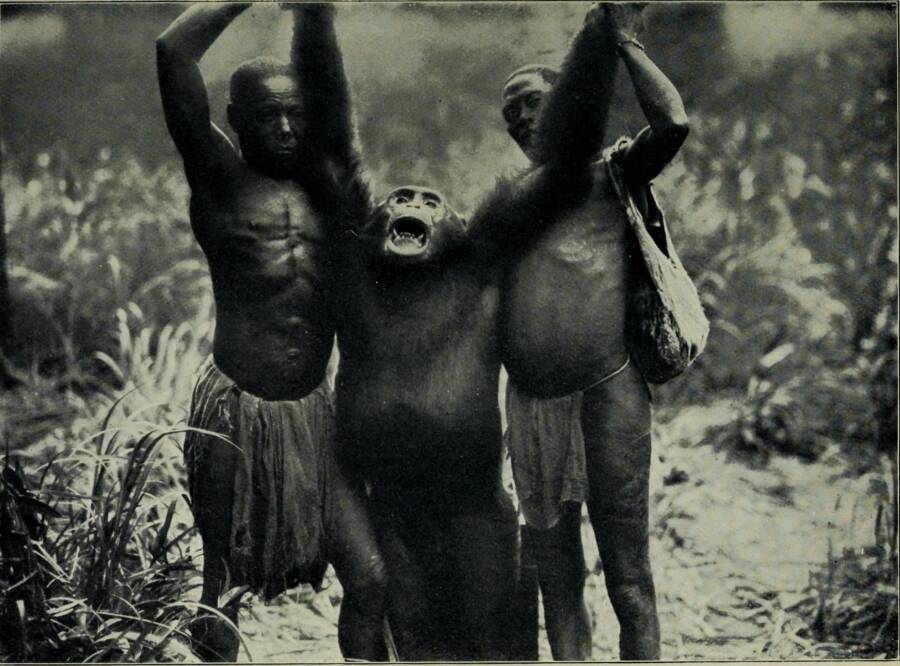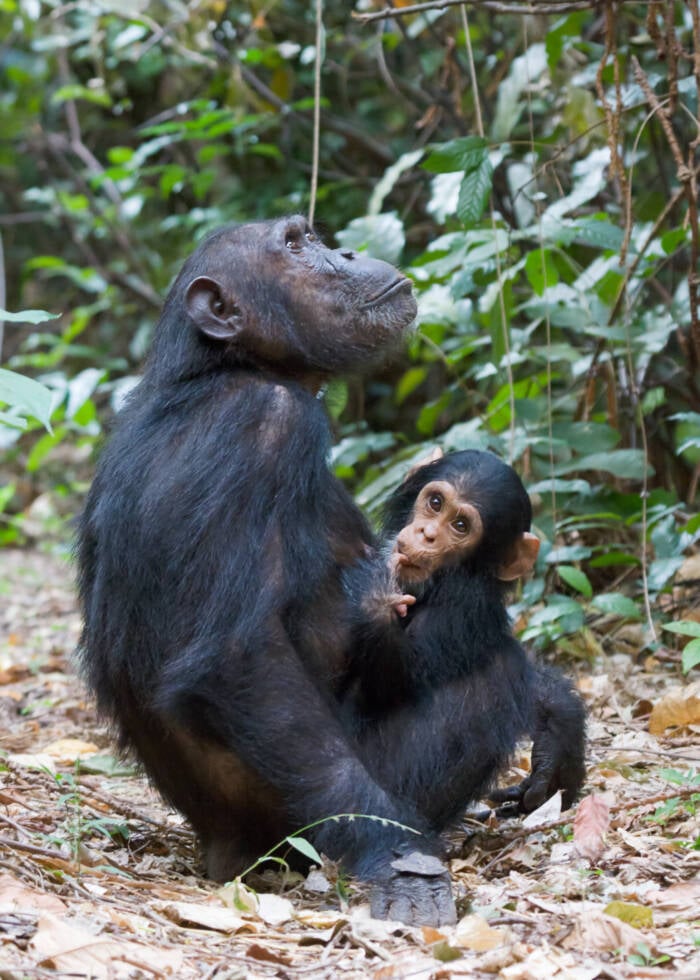
We have oversized genetic chimps. That makes it easy and there are also plenty of them. Behavior is divergent and they nest up on the ground.
all that makes for hunting bands that a lion will avoid. The legend conforms to all this..
Recall human sizing runs easily from five foot tall to seven foot tall and wight from 100 pounds through over two hundred non obese. What we are seeing is a similar spread.
At least it is DNA identidiable which is untrue for the Sasquatch.
Inside The Legend Of The Bondo Ape, The ‘Lion-Killing’ Primate Of The Congo
By Austin Harvey | Edited By Kaleena Fraga
Published January 10, 2024
Updated January 11, 2024
Rumors of so-called Bondo apes emerged around 2003 — when sensationalized reports about these highly aggressive, giant apes living in the Democratic Republic of the Congo began to spread online.
Wikimedia CommonsHunters holding what looks to be a giant chimpanzee.
In the 1990s, researchers in Belgium came across a strange skull that had been collected in Central Africa. Though it had some attributes of a gorilla, it also strangely resembled a chimpanzee. The skull seemed unique, and some primatologists came to believe that it belonged to a new species — the Bondo ape.
It soon came out that local hunters in the Democratic Republic of the Congo, where the skull had originally been found, had plenty of stories about a giant ape that prowled in the jungle. The creature was reportedly so powerful that it could kill a lion and survive being shot with poisoned arrows. Before long, the legend of the Bondo ape, also known as the Bili ape after a nearby village, began to spread far and wide.
So does the Bondo ape truly exist? Here’s what happened when researchers set out on the “ultimate adventure” to uncover the truth.
The Discovery Of A Mysterious Skull
In 1996, Swiss-Kenyan photographer and conservationist Karl Ammann came across an odd ape skull at the Royal Museum for Central Africa in Tervuren, Belgium. Though it had a “ridge” like a gorilla skull, it had originally come from a remote part of northern Congo — an area with no known gorilla population.
His interest piqued, Ammann decided to find out for himself if there were, in fact, gorillas in northern Congo, or if someone at the museum had misidentified the skulls.
He traveled to the Bili Forest, in the far north part of the Democratic Republic of Congo. The region had long been plagued by civil war, which meant that the jungle, though rich with wildlife, had long been inaccessible to researchers.
“This area is the last part of Africa where there are still wild animals,” pilot Ron Pontier, who grew up in the region, told Time in a 2005 interview. “It’s not a game park. It’s not a reserve. The animals are really wild.”
PA Images / Alamy Stock PhotoSwiss Wildlife photographer Karl Ammann.
“This was the ultimate adventure,” Ammann told NBC News. “It was in a part of Africa that nobody really knew anything about, even in colonial times.”
When he arrived, Ammann began speaking with locals in Bili to gather more information. He was told that the locals had put the apes in the nearby forests into two categories: the tree-beaters and the lion-killers. The latter of these were reportedly so massive and strong that they were seemingly immune to hunters’ poisoned arrows.
Then, Ammann’s interest turned into obsession.
The Hunt For The Bondo Ape
The more Ammann looked, the more clues he found about Bondo apes. He came across photos that showed hunters posing with an animal that looked to be nearly double the size of a standard chimp, several footprints larger than a gorilla’s, and a fecal dropping three times larger than a chimp’s.

Gable / Alamy Stock PhotoA sweep of forest in Bili.
Soon enough, Ammann’s hunt was joined by several other researchers, all determined to get to the bottom of this mystery group of apes.
One of the earliest researchers to arrive was primatologist Shelly Williams, who identified several characteristics of the Bondo apes. She noted that these mysterious apes had flatter faces and straight brows like a gorilla’s. Females lacked the genital swelling of other female chimpanzees. This group of mystery apes also made a unique vocalization that sounded like a howl — and they made this noise loudly when the moon rose and set.
“The unique characteristics they exhibit just don’t fit into the other groups of great apes,” Williams said. “At the very least, we have a unique, isolated chimp culture that’s unlike any that’s been studied.”
Williams’ observations were noteworthy, but her sensational description of what the team was looking for seemed to rub Ammann the wrong way. The hunt for the apes had now become something of a joke — as evidenced by an e-mail Ammann received, showing doctored photos of a chimp with a pug’s head and a seal with a gorilla’s face.
“Clearly, someone thinks we’re a joke,” he said at the time.
Others disagreed with Williams’ theories, including American primatologist Cleve Hicks, who joined the research team in 2004.

University of WarsawDr. Cleve Hicks, a primatologist who spent years in the Congo looking for the Bondo apes.
“I think people are going to be disappointed with the yeti in the forest,” he said. According to Hicks, the “mystery apes” he observed were clearly chimpanzees — some much larger than the average chimp, granted — but certainly not some new species.
The Surprising Find About Bondo Apes
Over the next several years, researchers made two important discoveries about Bondo apes. Motion-detecting cameras finally captured clear images of the creatures, and DNA from their feces confirmed that they were eastern chimpanzees (Pan troglodytes schweinfurthii).
“Genetically, they’re not even a subspecies,” Hicks explained. “But behaviorally, we may be seeing the beginning of a departure from chimpanzee norms. We could actually be catching evolution in the act. That is, if they’re allowed to survive.”

Ikiwaner/Wikimedia CommonsThe researchers determined that the so-called Bondo apes were actually genetically eastern chimpanzees, like the ones pictured here.
Still, these chimpanzees weren’t like others he had observed.
Hicks and other researchers documented unique behaviors among the chimps, and noted that a good portion of them grew to sizes much larger than average chimps. Like gorillas, they did have a ridge on their skulls, and they were seen smashing termite mounds and using rocks to crack open tortoise shells. Counter to Williams’ claim, female Bili apes did indeed display genital swelling similar to other chimpanzee
They also often opted to nest on the ground rather than in trees, despite the threats of predators like lions and leopards. They were even seen consuming leopard carcasses. But at the end of the day, they were chimpanzees through and through. Despite local legends suggesting the Bondo apes could walk on two legs or kill lions, neither of these claims has ever been proven.
“I don’t like to paint them as being more aggressive, but maybe they prey on some of these predators and the predators kind of leave them alone,” Hicks told The Guardian. “The ground nests were very big and there was obviously something very unusual going on there.”
Even more surprising were just how many chimps were in Bili. The forest there is vast and dense, and the chimps lived in scattered groups all throughout it, some in incredibly remote regions. Altogether, Hicks said it may be one of the biggest populations of wild chimpanzees in the world.
Moreover, it’s likely that few of them had even encountered humans before, let alone been hunted. As a result, the Bondo apes showed no signs of being afraid of humans, “just curiosity.”
“In fact, they seem like the boss when you get there,” Hicks said. “They are like ‘who are you to come into my kingdom?'”
At the end of the day, the true story of the Bondo ape is not the discovery of a new ape species, but rather a fascinating look at a uniquely isolated group of chimpanzees who have developed their own distinct culture.
It just goes to show — mysteries remain in the deepest reaches of the wild.
No comments:
Post a Comment